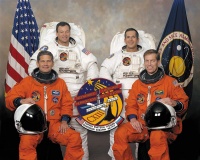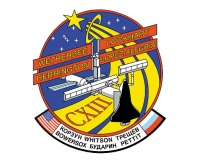STS-113
From The Space Library
 | |
| Organization | National Aeronautics and Space Administration (UnitedStates) |
|---|---|
| Mission type | Human Crew,Resupply/Refurbishment/Repair |
| Launch date | November 24, 2002 |
| Launch vehicle | Space Shuttle |
| Launch site | Cape Canaveral, United States |
| COSPAR ID | 2002-052A |
| Inclination | 51.6 degrees |
| Experiments | Here |
| Alternate Names | 27556 |
| Additional Information | Here |
| Data Collection | Here |
| Payload Mass Up | 13706.2 kg |
| Payload Mass Down | 1030.91 kg |
| Orbiter | Endeavour |
| Lift Off Mass | 2,055,113.18 kg |
| Orbiter Weight at Liftoff | 120,897.27 kg |
| Orbiter Weight at Landing | 91,667.27 kg |
| Landed | 2:37:12 p.m. EST, concrete runway 33, Kennedy Space Center, Fla. |
| Orbits of Earth | 215 |
| Orbital Altitude | 215 nautical miles |
Contents |
[edit] Crew
- Commander: James D. Wetherbee
- Pilot: Paul S. Lockhart
- Payload Commander:
- Mission Specialist 1: Michael E. Lopez-Alegria
- Mission Specialist 2: John B. Herrington
- Mission Specialist 3:
- Mission Specialist 4:
- Mission Specialist 5:
- Payload Specialist 1:
- Payload Specialist 2:
ISS/Mir Crew Transport
[edit] Mission
STS 113 was an American shuttle spacecraft. It was the 19th flight of the Endeavour orbiter and the 112th shuttle mission to be flown. It carried a crew of seven astronauts (six American and one Russian) and the main hardware, a 13.7 m truss of 12.5 tonne to the International Space Station (ISS). During several hours of EVA, the crew installed and secured the truss assembly which now has a total length of 40.8 m. The truss will provide structural support to the station's thermal control radiators, besides enabling a manually operated cart to move along it during EVAs. The total mass of the ISS is now about 200 tonnes. Prior to leaving the ISS, the shuttle deployed a pair of tethered (15 m long) picosatellites, called MEPSI. It left the ISS on 02 December 2002 and returned to Earth on 04 December 2002, leaving behind three of its astronauts for a long stay at the ISS and bringing back the rest of the crew and the three astronauts who had stayed in ISS for about six months.
[edit] EVA
Extravehicular Activity (EVA) conducted by Michael Lopez-Alegria and John Herrington from joint airlock "Quest" during three spacewalks for a total of 19 hours, 55 minutes ISS robot arm operators: Peggy Whitson, Ken Bowersox, and Don Pettit. Space shuttle robot arm operator: Jim Wetherbee. EVA 1, 6 hours, 45 minutes; after the P1 was attached to the station, Lopez-Alegria and Herrington started installing connections between the P1 and the S0 truss. They installed onto the Unity node the wireless video system external transceiver assembly, which will be used to support spacewalkers' helmet cameras. Herrington released launch restraints on the CETA cart. EVA 2, 6 hours, 10 minutes; Lopez-Alegria and Herrington installed another wireless video system external transceiver assembly onto the P1 and relocated the CETA cart from the P1 to the S1 truss, which will allow the mobile transporter to move along the P1 to assist in future assembly missions. EVA 3, 7 hours, 0 minute; Lopez-Alegria and Herrington installed additional Spool Positioning Devices, reconfigured electrical harnesses, and attached ammonia tank assembly lines.
[edit] Payload
ISS Assembly Flight 11A; 14-ton Port-One (P1) truss structure preintegrated with Ultra-high Frequency (UHF) communication equipment, Thermal Radiator Rotary Joint (TRRJ), three External Active Thermal Control System (EATCS) radiators, Direct Current (DC)-to-DC Converter Unit (DDCU), Remote Power Controller Module (RPCM), Nitrogen Tank Assembly (NTA), Ammonia Tank Assembly (ATA), and Pump Module Assembly (PMA); second Crew and Equipment Translation Aid (CETA) cart that can be manually operated along the Mobile Transporter rail line; Micro-Electromechanical System (MEMS)Based Pico Satellite (PICOSAT) Inspector (MEPSI); fifth ISS crew exchange
[edit] Books about the Space Shuttle Program
Buy This Book Click here |
Buy This Book here |
Buy This Book Click here |
Buy This Book Click here |





